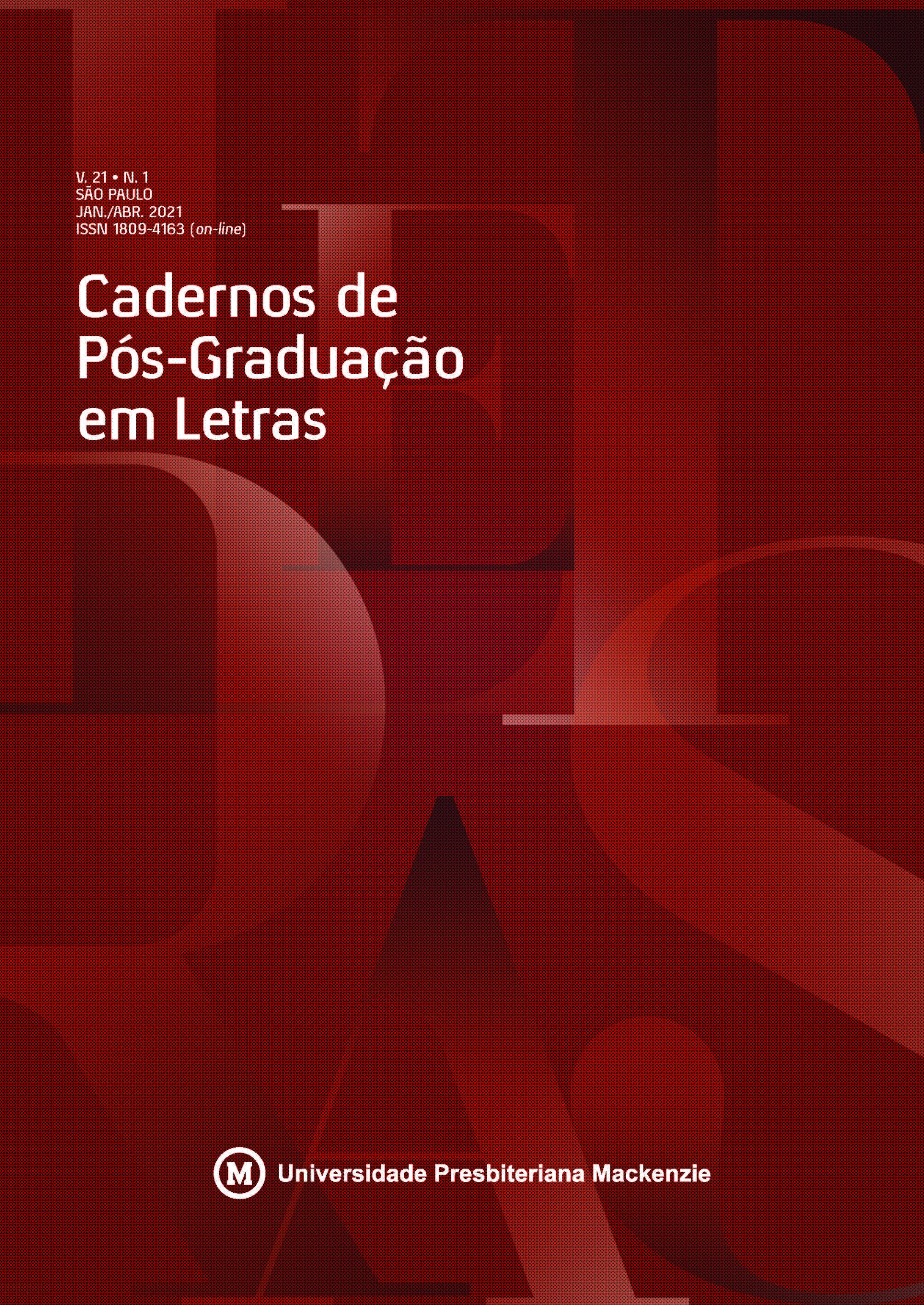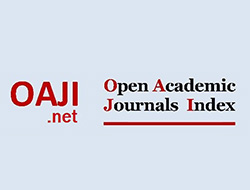A femme fatale como duplo em Gastão Cruls
Keywords:
Gastão Cruls, duplo, femme fataleAbstract
In this article my aim is to examine how Gastão Cruls uses the “obsessive images [images obsédantes]” of decadent fiction to create a fantastic narrative about duplicity.
Downloads
Download data is not yet available.
References
BARRETO, L. À margem do ‘Coivara’, de Gastão Cruls. In: ______. Impressões de leitura e outros textos críticos. São Paulo: Companhia das Letras, 2017. p. 253-258.
BONAPARTE, M. The life and works of Edgar Allan Poe: a psycho-analytic interpretation. Londres: Imago Publishing, 1949.
BOTTING, F. Gothic. Londres; Nova York: Routledge, 1996.
BRAVO, N. F. Doubles and counterparts. In: BRUNEL, Pierre (ed.). Companion to literary myths, heroes and archetypes. Londres: Routledge, 1996. p. 343-382.
BRAVO, V. A. La irrupción y el límite: hacia una reflexión sobre la narrativa fantástica y la naturaleza de la ficción. México: Universidad Nacional Autónoma de México, 1988.
BROCA, B. Naturalistas, parnasianos e decadistas: vida literária do Realismo ao Pré-modernismo. Campinas: Editora da Unicamp, 1991.
CAVALCANTI, L.. Elsa e Elena. Leitura, Rio de Janeiro, p. 31, mar. 1944.
CESERANI, R. O fantástico. Tradução de Nilton Cezar Tridapalli. Curitiba: Ed. UFPR, 2006.
CRULS, G. Elza e Helena. Romance. São Paulo: Companhia Editora Nacional, 1949.
______. O espelho. In: ______. Contos reunidos. Rio de Janeiro: José Olympio Editora, 1951. p. 339-348.
ECO, U. De los espejos. In: ______. De los espejos y otros ensayos. [S.l.]: Debolsillo, 2012, locais 40-587. Edição do Kindle.
FRANÇA, J. Ecos da pulp era no Brasil: o Gótico e o Decadentismo em Gastão Cruls. Terra roxa e outras terras: Revista de estudos literários. Londrina, v. 26, p. 7-17, dez. 2013.
______; SILVA, D. A. P. De perseguidas a fatais: personagens femininas, sexo e horror na literatura de medo brasileira. Revista Opiniães: Revista dos alunos de Literatura Brasileira, Letras e Ciências Humanas da Universidade de São Paulo. São Paulo, v. 5, n. 6/7, p. 51-66, 2015.
GAGNIER, R. The Victorian fin de siècle and Decadence. In: MARCUS, Laura; NICHOLLS, Peter. The Cambridge history of twentieth-Century English literature. v. 1. Cambridge: Cambridge University Press, 2004. p. 30-49.
JOUVE, S. Les décadents. Bréviaire fin de siècle. Paris: Plon, 1989.
LARA, C. de. Literatura fantástica e o Modernismo. Jornal O Estado de S. Paulo, São Paulo, n. 150, p. 10-11, 16 set. 1979.
LOPES, H. Literatura fantástica no Brasil. Revista Língua e Literatura, São Paulo, v. 4. FFLCH, USP, p. 185-199, 1975.
OLIVER, M. The bright eyes of Eleonora: Poe’s dream of recapturing the impossible. In: ______. Upstream. Selected essays. Nova York: Penguin Press, 2016. p. 61-71.
POE, E. A. The philosophy of composition. Graham’s Magazine, vol. XXVIII, n. 4, p. 163-167, abr. 1846.
______. Tales of mystery and imagination. Londres: Everyman’s Library, 1908.
RANCY, C. Fantastique et décadence en Angleterre: 1890-1914. Paris: Éditions du CNRS, 1982.
RUDDICK, N. The fantastic fiction of the fin de siècle. In: MARSHALL, Gail. The Cambridge companion to the fin de siècle. Cambridge: Cambridge University Press, 2007. p. 189-206.
SENNA, H. Lembrança de Gastão Cruls. Correio da Manhã, Rio de Janeiro, p. 8, 20 jun. 1959.
SODRÉ, N. M. Os livros de Cronin. Correio da Manhã, Rio de Janeiro, p. 5, 15 set. 1940.
STEVENSON, R. L. O médico e o monstro: o estranho caso do dr. Jekyll e sr. Hyde. Tradução de Jorio Dauster. São Paulo: Penguin/Companhia das Letras, 2015. Edição do Kindle.
SYMONS, J. The tell-tale heart: the life and works of Edgar Allan Poe. Middlesex: Penguin Books, 1978.
WEBBER, A. J. The Doppelgänger: double visions in German literature. Nova York: Oxford University Press, 1996.
WEIR, D. Afterword: Decadent taste. In: CONDÉ, Alice; DESMARAIS, Jane. Decadence and the senses. Cambridge: Legenda, 2017. p. 219-228.
ZIOLKOWSKI, Th. Disenchanted images: a literary iconology. Princeton: Princeton University Press, 1977.
BONAPARTE, M. The life and works of Edgar Allan Poe: a psycho-analytic interpretation. Londres: Imago Publishing, 1949.
BOTTING, F. Gothic. Londres; Nova York: Routledge, 1996.
BRAVO, N. F. Doubles and counterparts. In: BRUNEL, Pierre (ed.). Companion to literary myths, heroes and archetypes. Londres: Routledge, 1996. p. 343-382.
BRAVO, V. A. La irrupción y el límite: hacia una reflexión sobre la narrativa fantástica y la naturaleza de la ficción. México: Universidad Nacional Autónoma de México, 1988.
BROCA, B. Naturalistas, parnasianos e decadistas: vida literária do Realismo ao Pré-modernismo. Campinas: Editora da Unicamp, 1991.
CAVALCANTI, L.. Elsa e Elena. Leitura, Rio de Janeiro, p. 31, mar. 1944.
CESERANI, R. O fantástico. Tradução de Nilton Cezar Tridapalli. Curitiba: Ed. UFPR, 2006.
CRULS, G. Elza e Helena. Romance. São Paulo: Companhia Editora Nacional, 1949.
______. O espelho. In: ______. Contos reunidos. Rio de Janeiro: José Olympio Editora, 1951. p. 339-348.
ECO, U. De los espejos. In: ______. De los espejos y otros ensayos. [S.l.]: Debolsillo, 2012, locais 40-587. Edição do Kindle.
FRANÇA, J. Ecos da pulp era no Brasil: o Gótico e o Decadentismo em Gastão Cruls. Terra roxa e outras terras: Revista de estudos literários. Londrina, v. 26, p. 7-17, dez. 2013.
______; SILVA, D. A. P. De perseguidas a fatais: personagens femininas, sexo e horror na literatura de medo brasileira. Revista Opiniães: Revista dos alunos de Literatura Brasileira, Letras e Ciências Humanas da Universidade de São Paulo. São Paulo, v. 5, n. 6/7, p. 51-66, 2015.
GAGNIER, R. The Victorian fin de siècle and Decadence. In: MARCUS, Laura; NICHOLLS, Peter. The Cambridge history of twentieth-Century English literature. v. 1. Cambridge: Cambridge University Press, 2004. p. 30-49.
JOUVE, S. Les décadents. Bréviaire fin de siècle. Paris: Plon, 1989.
LARA, C. de. Literatura fantástica e o Modernismo. Jornal O Estado de S. Paulo, São Paulo, n. 150, p. 10-11, 16 set. 1979.
LOPES, H. Literatura fantástica no Brasil. Revista Língua e Literatura, São Paulo, v. 4. FFLCH, USP, p. 185-199, 1975.
OLIVER, M. The bright eyes of Eleonora: Poe’s dream of recapturing the impossible. In: ______. Upstream. Selected essays. Nova York: Penguin Press, 2016. p. 61-71.
POE, E. A. The philosophy of composition. Graham’s Magazine, vol. XXVIII, n. 4, p. 163-167, abr. 1846.
______. Tales of mystery and imagination. Londres: Everyman’s Library, 1908.
RANCY, C. Fantastique et décadence en Angleterre: 1890-1914. Paris: Éditions du CNRS, 1982.
RUDDICK, N. The fantastic fiction of the fin de siècle. In: MARSHALL, Gail. The Cambridge companion to the fin de siècle. Cambridge: Cambridge University Press, 2007. p. 189-206.
SENNA, H. Lembrança de Gastão Cruls. Correio da Manhã, Rio de Janeiro, p. 8, 20 jun. 1959.
SODRÉ, N. M. Os livros de Cronin. Correio da Manhã, Rio de Janeiro, p. 5, 15 set. 1940.
STEVENSON, R. L. O médico e o monstro: o estranho caso do dr. Jekyll e sr. Hyde. Tradução de Jorio Dauster. São Paulo: Penguin/Companhia das Letras, 2015. Edição do Kindle.
SYMONS, J. The tell-tale heart: the life and works of Edgar Allan Poe. Middlesex: Penguin Books, 1978.
WEBBER, A. J. The Doppelgänger: double visions in German literature. Nova York: Oxford University Press, 1996.
WEIR, D. Afterword: Decadent taste. In: CONDÉ, Alice; DESMARAIS, Jane. Decadence and the senses. Cambridge: Legenda, 2017. p. 219-228.
ZIOLKOWSKI, Th. Disenchanted images: a literary iconology. Princeton: Princeton University Press, 1977.
Downloads
Published
2021-05-24
How to Cite
Resende, A. (2021). A femme fatale como duplo em Gastão Cruls. Cadernos De Pós-Graduação Em Letras, 21(1), 58–72. Retrieved from http://editorarevistas.mackenzie.br/index.php/cpgl/article/view/14270
Issue
Section
Dossier
License
The copyright of the articles published in Cadernos de Pós-Graduação em Letras belongs to the authors, who grant the Mackenzie Presbyterian University the exclusive rights to publish the content. Total or partial reproduction is prohibited without due authorization from the Editorial Committee, except for study and research.











